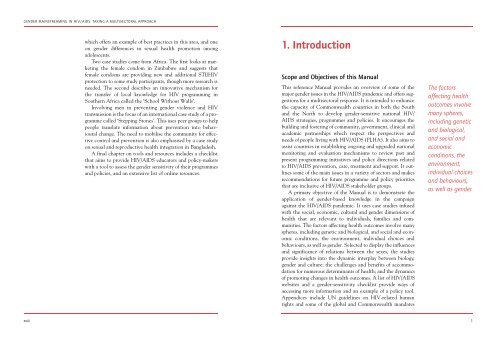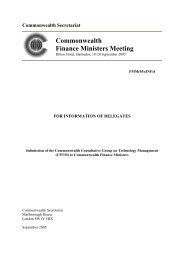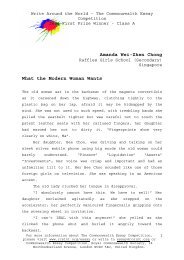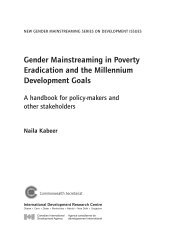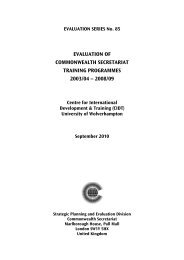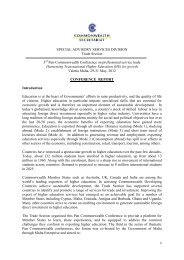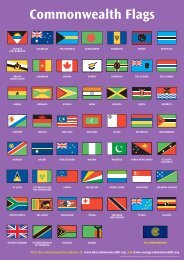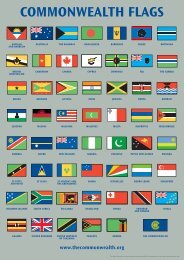Gender Mainstreaming in HIV/AIDS - Commonwealth Secretariat
Gender Mainstreaming in HIV/AIDS - Commonwealth Secretariat
Gender Mainstreaming in HIV/AIDS - Commonwealth Secretariat
Create successful ePaper yourself
Turn your PDF publications into a flip-book with our unique Google optimized e-Paper software.
GENDER MAINST R E A M I NG IN <strong>HIV</strong>/<strong>AIDS</strong>: TA K I NG A MULT I S E C TORAL APPROACH<br />
which offers an example of best practices <strong>in</strong> this area, and one<br />
on gender differences <strong>in</strong> sexual health promotion among<br />
adolescents.<br />
Two case studies come from Africa. The first looks at market<strong>in</strong>g<br />
the female condom <strong>in</strong> Zimbabwe and suggests that<br />
female condoms are provid<strong>in</strong>g new and additional STI/<strong>HIV</strong><br />
protection to some study participants, though more research is<br />
needed. The second describes an <strong>in</strong>novative mechanism for<br />
the transfer of local knowledge for <strong>HIV</strong> programm<strong>in</strong>g <strong>in</strong><br />
Southern Africa called the ‘School Without Walls’.<br />
Involv<strong>in</strong>g men <strong>in</strong> prevent<strong>in</strong>g gender violence and <strong>HIV</strong><br />
transmission is the focus of an <strong>in</strong>ternational case study of a programme<br />
called ‘Stepp<strong>in</strong>g Stones’. This uses peer groups to help<br />
people translate <strong>in</strong>formation about prevention <strong>in</strong>to behavioural<br />
change. The need to mobilise the community for effective<br />
control and prevention is also emphasised by a case study<br />
on sexual and reproductive health <strong>in</strong>tegration <strong>in</strong> Bangladesh.<br />
A f<strong>in</strong>al chapter on tools and resources <strong>in</strong>cludes a checklist<br />
that aims to provide <strong>HIV</strong>/<strong>AIDS</strong> educators and policy-makers<br />
with a tool to assess the gender sensitivity of their programmes<br />
and policies, and an extensive list of onl<strong>in</strong>e resources.<br />
1. Introduction<br />
This reference Manual provides an overview of some of the<br />
major gender issues <strong>in</strong> the <strong>HIV</strong>/<strong>AIDS</strong> pandemic and offers suggestions<br />
for a multisectoral response. It is <strong>in</strong>tended to enhance<br />
the capacity of <strong>Commonwealth</strong> countries <strong>in</strong> both the South<br />
and the North to develop gender-sensitive national <strong>HIV</strong>/<br />
<strong>AIDS</strong> strategies, programmes and policies. It encourages the<br />
build<strong>in</strong>g and foster<strong>in</strong>g of community, government, cl<strong>in</strong>ical and<br />
academic partnerships which respect the perspectives and<br />
needs of people liv<strong>in</strong>g with <strong>HIV</strong>/<strong>AIDS</strong> (PLHA). It also aims to<br />
assist countries <strong>in</strong> establish<strong>in</strong>g ongo<strong>in</strong>g and upgraded national<br />
monitor<strong>in</strong>g and evaluation mechanisms to review past and<br />
present programm<strong>in</strong>g <strong>in</strong>itiatives and policy directions related<br />
to <strong>HIV</strong>/<strong>AIDS</strong> prevention, care, treatment and support. It outl<strong>in</strong>es<br />
some of the ma<strong>in</strong> issues <strong>in</strong> a variety of sectors and makes<br />
recommendations for future programme and policy priorities<br />
that are <strong>in</strong>clusive of <strong>HIV</strong>/<strong>AIDS</strong> stakeholder groups.<br />
A primary objective of the Manual is to demonstrate the<br />
application of gender-based knowledge <strong>in</strong> the campaign<br />
aga<strong>in</strong>st the <strong>HIV</strong>/<strong>AIDS</strong> pandemic. It uses case studies <strong>in</strong>fused<br />
with the social, economic, cultural and gender dimensions of<br />
health that are relevant to <strong>in</strong>dividuals, families and communities.<br />
The factors affect<strong>in</strong>g health outcomes <strong>in</strong>volve many<br />
spheres, <strong>in</strong>clud<strong>in</strong>g genetic and biological, and social and economic<br />
conditions, the environment, <strong>in</strong>dividual choices and<br />
behaviours, as well as gender. Selected to display the <strong>in</strong>fluences<br />
and significance of relations between the sexes, the studies<br />
provide <strong>in</strong>sights <strong>in</strong>to the dynamic <strong>in</strong>terplay between biology,<br />
gender and culture; the challenges and benefits of accommodation<br />
for numerous determ<strong>in</strong>ants of health; and the dynamics<br />
of promot<strong>in</strong>g changes <strong>in</strong> health outcomes. A list of <strong>HIV</strong>/<strong>AIDS</strong><br />
websites and a gender-sensitivity checklist provide ways of<br />
access<strong>in</strong>g more <strong>in</strong>formation and an example of a policy tool.<br />
Appendices <strong>in</strong>clude UN guidel<strong>in</strong>es on <strong>HIV</strong>-related human<br />
rights and some of the global and <strong>Commonwealth</strong> mandates<br />
The factors<br />
affect<strong>in</strong>g health<br />
outcomes <strong>in</strong>volve<br />
many spheres,<br />
<strong>in</strong>clud<strong>in</strong>g genetic<br />
and biological,<br />
and social and<br />
economic<br />
conditions, the<br />
environment,<br />
<strong>in</strong>dividual choices<br />
and behaviours,<br />
as well as gender.<br />
xviii 1


